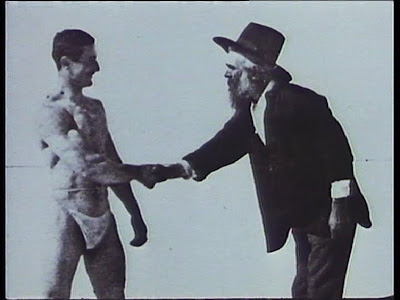Perhaps inspired by the way a flying trapezist orients himself in the 3-dimensional space of the big top using the balancing mechanisms of his semi-circular canals, it was Nanneman’s belief that movie audiences could be guided through the hidden substructures of a movie by their ears, although in this case through the use of structural sound mapping* rather than endolymphatic stimulation. With every last component of a Redestructivish film chosen from the finite (if massive) selection listed in the Catalogue, it was possible to assign each component (be it a character, a costume, a feeling or whatever) a more or less noticeable sound identity quite aside from any specific functional sound it might be associated with on a narrative level. Thus, an audience member should be able to position himself in relation to a Redestructivish movie’s invisible moral or sartorial or emotional framework at any point during a screening, by triangulating the sound identities of each activated component. It was Nanneman’s claim that, much like the trapezist (or man on the street) whose sense of balance is essentially an automatic process (with conscious attention demanded by the tricky bits), the audience would rarely have to work at recognising these sonically-highlighted substructures, although Hanni suggested that was a slightly optimistic view of how the human mind works.
Nanneman coined the term ‘Destructural Sound’ to refer to a recurring technical fault within this system whereby sounds intended to be ‘structural’ would leak between the materials of a film’s architecture, warping or even demolishing that movie’s substructures even as it unfolded.
For the most part, when this inexplicable glitch occurred, sound identities would jump between components, even between those components that did not feature together in the same scenes; some would become completely detached from their intended components and float freely through a movie without becoming attached to other components; still other sound identities would spontaneously begin to mimic adjacent components creating meshes of unintended meaning, exposing oversimplified versions of unintended undercurrents to anyone who was listening carefully. Hanni reassured Nanneman that such audience members would be few and far between, and that to the casual viewer of these early test movies the Destructural Sound - if noticed at all - would probably be attributed to faulty speakers. Still, Nanneman could only hear these distortions as structural damage and, when a remedy was not forthcoming, he instead opted to recast the defect in a positive light.
Nanneman’s suggestion that a filmmaker using the Catalogue to create a Redestructivish movie might "encourage" the phenomenon of Destructural Sound merely by the (non)-act of not correcting it when it occurred might seem disingenuous. Rather than taking the blame, wasn’t Nanneman attempting to take credit, as conceiver and craftsman, for what was essentially a major fault in the Redestructivish system? Was not his capitalisation of the very term Destructural Sound the equivalent of a car manufacturer trademarking the phrase "break down"?
In fact, the period that Nanneman spent developing sounds and sound systems for the Catalogue was, for him, a deeply troubling time, in which he lost faith in himself as a facilitator and an engineer. He had designed himself into a corner, considered himself professionally stranded and, despite his stated goal of facilitating films that would reassure the nation’s unsettled populace, he perhaps saw in the phenomenon of Destructural Sound an apt and personally comforting structural/aesthetic analogy for his own condition - and by extension a valid artistic mechanism. An audience member trying too hard to navigate the hidden substructures of a Redestructivish movie could now become literally ‘lost’ in it.
Of course, Nanneman eventually worked his way through his sound issues, variously fixing or explaining away or forgetting about the Catalogue’s audio shortcomings, the plain passing of time allowing him to look back on that period as what he might characteristically have called a "forest/trees" situation. All the same, once in the clear Nanneman never returned to confront the "forest" of sound in which he had become so lost: the flaws and their euphemistic labels remained integral to the Redestructivish package. The turmoil that Destructural Sound would have made on the cinema sound system repairs industry had the Catalogue ever progressed beyond the test stage can only be imagined.
*(not to be confused with geographic sound mapping in the films of Francis Dove, whose ever diminishing budgets saw an increasing reliance on sets built from light, fog and upturned boxes and who therefore oriented audiences in his characters’ surroundings through the use of consistent and aggressive soundscaping)
See also: Foley Bleed





















